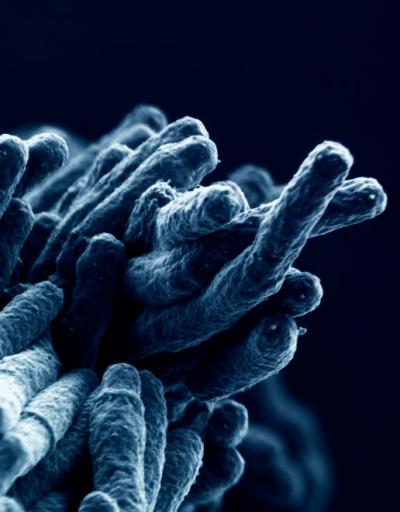![Colorized electron microscopy image of Mycobacterium tuberculosis.[Andrea Ablasser/EPFL]](https://genengnews.com/wp-content/uploads/2018/08/92802_web1511554213-1.jpg)
Colorized electron microscopy image of Mycobacterium tuberculosis.[Andrea Ablasser/EPFL]
Although the global death rate has dropped 45% since 1990, Mycobacterium tuberculosis (Mtb) still remains one of the most deadliest diseases as one third of the world’s population is infected—2013 saw 9 million case of TB and 1.5 million Mtb-related deaths. Yet, all is not bleak as Mtb, in many cases, is manageable through the use of antibiotic cocktail therapy. However, drug resistance is a constant threat and is on the rise in many parts of the world. Understanding the molecular underpinnings of this disease is paramount to developing new, more effective treatments.
For many years scientists have understood that a patient’s immune response is critical to how the disease will progress—either helping the body fight the bacterium or, if certain key molecules become involved, actually exacerbating the infection. Now, scientists from the Swiss Federal Institute of Technology in Lausanne (EPFL) have shown how the tuberculosis bacterium hijacks mechanisms of the host immune system to its own advantage.
The findings from this study were published recently in Cell Host Microbe through an article entitled “Mycobacterium tuberculosis Differentially Activates cGAS- and Inflammasome-Dependent Intracellular Immune Responses through ESX-1.”
Typically, when Mtb infects an individual it will invade the macrophages of the lungs, setting off a protein signaling cascade called the inflammasome, whose main role is to prepare specific immunity proteins in the macrophages, called interleukins.
When left unchecked, this first line defense mechanism from the interleukins can cause serious damage to host cells. To combat this, macrophages also release another group of proteins called type I interferons (IFN). Typically, interferons are important for defending the body against viruses, however when it comes to tuberculosis they actually help the bacterium, thereby exacerbating the disease—a process that has puzzled scientists for many years.
The EPFL scientists discovered a key molecule that Mtb exploits to persist within the host macrophages called cyclic GMP-AMP synthase (cGAS), which is part of a group of DNA-sensor molecules. cGAS resides within macrophages and triggers the release of interleukin-1 and IFN in the presence of foreign pieces of DNA.
“We demonstrate that the cytosolic DNA sensor cGAS is essential for initiating an IFN response to Mtb infection. cGAS associates with Mtb DNA in the cytosol to stimulate cyclic GAMP (cGAMP) synthesis,” the scientists explained.
The researchers found that Mtb uses a specialized secretion system to release an array of toxic proteins within the macrophage along with bits of DNA, which are picked up by cGAS, thereby tricking the host cell to signal the production of IFN, which reduces the immune response. In other words, Mtb cleverly deceives the macrophages to cut back on their defense against the microbe.
“Our findings identify cGAS as an innate sensor of Mtb and provide insight into how ESX-1 controls the activation of specific intracellular recognition pathways,” stated the scientists.
The investigators also showed that it was possible to manipulate Mtb so that it could no longer activate the production of interferons through cGAS, while still keeping the production of interleukin-1 and the host immune response intact.
“Our work shows that tuberculosis is a far more sophisticated disease than previously thought,” concluded Andrea Ablasser, Ph.D., assistant professor at the EPFL and senior author on the current study.


